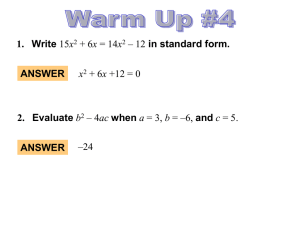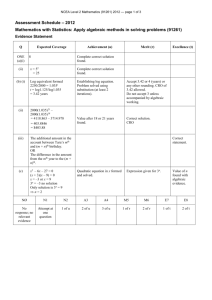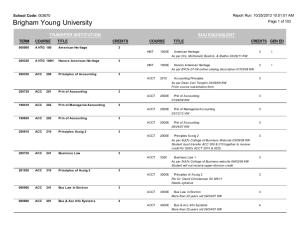0. Numerical Computing and Computers
advertisement
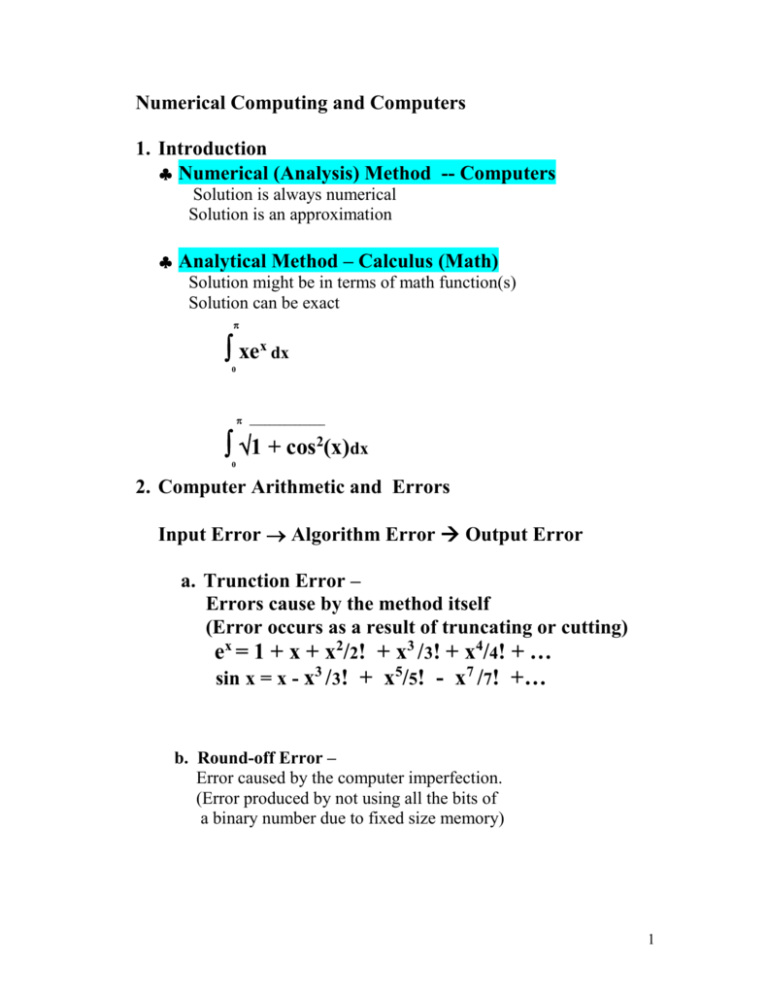
Numerical Computing and Computers
1. Introduction
Numerical (Analysis) Method -- Computers
Solution is always numerical
Solution is an approximation
Analytical Method – Calculus (Math)
Solution might be in terms of math function(s)
Solution can be exact
xex dx
0
_______________
1 + cos2(x)dx
0
2. Computer Arithmetic and Errors
Input Error Algorithm Error Output Error
a. Trunction Error –
Errors cause by the method itself
(Error occurs as a result of truncating or cutting)
ex = 1 + x + x2/2! + x3 /3! + x4/4! + …
sin x = x - x3 /3! + x5/5! - x7 /7! +…
b. Round-off Error –
Error caused by the computer imperfection.
(Error produced by not using all the bits of
a binary number due to fixed size memory)
1
Real Number
-------------------------------------
__
Rational
Irrational 2,
__________
Integers
Fractions
How are numbers stored in a computer?
How are they combined?
What effect do these machine features have on numerical result?
================== 8/26/2003 ==============
a. Integer number numbers
Adv –
Exactly represented in computer memory (no round-off errors)
Fast, simple, and accurate in computation
Disadv –
Cannot handle fraction numbers
Small range of representation (ex. –235 ~ 235-1)
b. Floating point numbers
Adv –
Can handle fraction
Much larger range of representation (1075 ~ 10-79 -1)
DisAdv –
Slower and round-off error
Many decimal fractions cannot be exactly represented in the binary system
Math ---- Real Numbers -- Continuous, infinite, uniformly distributed
Computer --- Floating point numbers -- not continuous, finite, not uniformly distri.
Mapping – real numbers (infinite set) and floating point numbers (finite set)
Real Number line
……………………….
Floating point number . . .
…………. .
–1 0 +1
continuous, infinite, uniformly
. not cont, finite, not uniformly distr
2
Floating-point numbers -- Closely packed near 0
Many floating points can not be represented precisely.
They are sparsely packed as they are far away from 0.
Round-off Error – (conti)
Error caused by the computer imperfection.
(Error produced by not using all the bits of a binary number
due to fixed memory size)
a. Can’t be exactly represented due to limited word size.
(0.1)10 = (0.001100110011………..) 2
(0.6)10 = (0.100110011………..) 2
Normalized and un-normalized
CMPS 391 – Imaginary Computer
sign
mantissa
x
xxxx
exponentiation
x
0.1001
+ 0.1100
----------------
1.0101
Normalize ------------>
sign
+
mantissa
0.1010
exponentiation (characteristic)
x
S = 1 - ½ + 1/3 - ¼ + 1/5 - 1/6 +… =
[(-1)n+1 /n]
n=1
1 = 0.1000E +1
½ = 0.1000E +0
1/3 = (0.33333333) = (0.010101…) 2 = (0.1010E-1)
1/4 = 0.1000E –1
1/5 = (0.2) 10 = (0.001100110011….) 2 = (0.1100E-2)
S = (0.1000E+1)-(0.1000E+0)+(0.1010E-1)-(0.1000E–1)+(0.1100E-2)- … = 0.5625…
Tv = True Value = 0.69314718 …
Av = Approx Value = 0.5625…
Absolute Error = Tv –Av = 0.1306471
Relative Error = Abso value / Tv = 0.1308471 / 0.69314718 .. = 0.18
3
Causes of serious round-off errors –
A. Adding (subtracting) a large number to (from) a small number
CS391 COMPUTER
± d1d2 d3 d4 * Be
ex.1
x = 0.3555E+2
y = 0.2333E-2
0.3555
+0.00002333
z = 0.8222E-2
0.3555
+ 0.000082
--------------
--------------
0.3555 E+2
0.3555 E+2
(x + y) + z = x + (y + z)
0.2333
+0.8222
============
1.0555 E-2
0.3555
+ 0.00010555
============
0.3556 E+2
ex.2
S = 1 + 1/3 + 1/9 + 1/27 + …=
[1/3n] = 1.5
n=0
One term S = 1
----------------------------------------Two terms S = 1+1/3 = 4/3 = 1.33333 -------------------Three terms S = 1 + 1/3 + 1/9 = 13/9 = 1. 44444-----------
Relative Error
~ 0.5 / 1.5 = 33%
~11%
~ 4%
Avoid adding a large number to a small number
Remedy -S = ((((1+1/3)*1/3 +1) 1/3+1)*1/3 +1)….
or
In case n = 7 (terms) --Sum the series backward -- avoid adding a large number to a small number
S = (1 + (1/3 + (1/9 + (1/27 + (1/81 + (1/243 +1/729)))))) ~
4
ex3.
ax2 + bx + c = 0
if b2 - 4ac ≈ b2
_______
x = [-b b2 - 4ac ] / [2a]
x1 = -b/a ,
x2 = 0
( b2 >>>>>>>>>>>4ac )
if ( b2 - 4ac ) ≈ b2
not accurate (error)
x2 - 105 x + 1 = 0
__________
5
x1 = {10 - [(10)5] 2 – 4 } / 2 * ----- rationalize ….. 105
___________
x2 = {105 + [(10)5] 2 – 4 } / 2 * ----- rationalize ---- undefined
f(x) = ax2 + bx + c = 0
***
x=
Rationalization
_______
[-b- b2 - 4ac ] / [2a] ,
_______
rationalize = [2c] / [ -b+ b2 - 4ac ]
*** Factoring to improve the accuracy of the result(s)
f(x) = ax2 + bx + c = a[(x –p)(x-q)] = a[x2 - (p+q)x + pq]
p+q = -b/a and pq = c/a
B. Subtracting two almost equal numbers
ex1.
x = 0.32425 E2 ,
y= 0.32300E2
0.324 E2 - 0.323 E2 = 0.001E2 = 0.100E0
True value = 0.125 E0
Relative error = | 0.125 - 0.100| ∕ | 0.125 | = 5/25 = 20%
ex2.
______
10002
--
_______
10000 ~~~
0
These two numbers might be stored exactly the same internally
______
______
10002 - 10000 = 2/20 = 0.1 (rationalize)
5
6
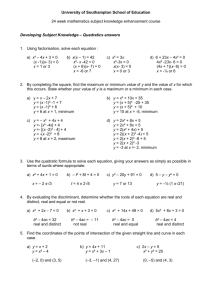
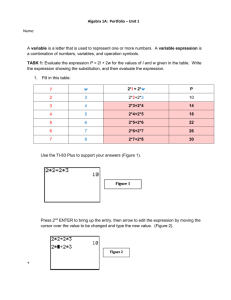
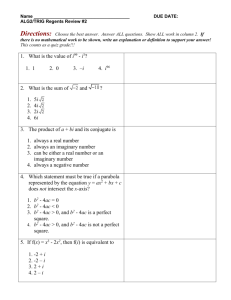
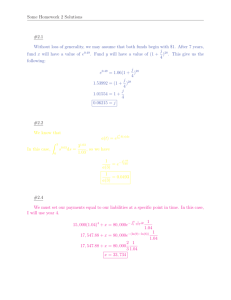
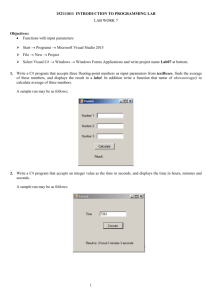
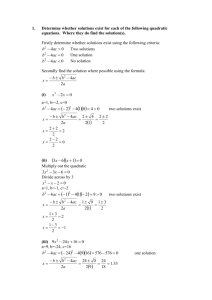
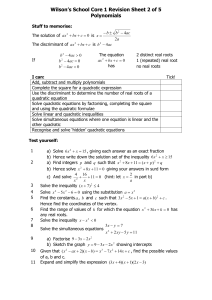
![is a polynomial of degree n > 0 in C[x].](http://s3.studylib.net/store/data/005885464_1-afb5a233d683974016ad4b633f0cabfc-300x300.png)
